|
 |
 |
 |
 |
 |
 |
 |
 |
 |
 |
|
The equiworld.net magazine
Online Magazine
December 2000
This section will keep you up to date with all the changes that are taking
place. Please let us know what you think, your feedback is always appreciated,
email info@equiworld.com
| Equestrian
Shopping Online
|
| 31st December
2000 |
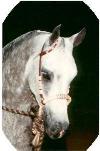 |
The Arab
The Arabian could be the oldest known
pure breed. It has influenced, directly or indirectly, all light saddle breeds,
all warmblood breeds and most pony breeds in Europe, including the Percheron,
Swedish Warmblood, Russian Orlov, Standardbred, Thoroughbred, all American
Gaited Horses, Quarter Horse, Morgan, Connemara and Paso Fino. |
A distinctive skeletal feature of the Arab is
less vertebrae: 5 lumbar, 17 rib, and 16 tail, compared with 6-18-18 in other
breeds. Their action is floating -- a full, free trot with little knee action.
In temperament, Arabians are intelligent, affectionate, fiery, courageous,
gentle, with high self-esteem.
Please click here to learn more |
| 31st December
2000 |
Improving Gaits Through Clicker Training
On the ground one of the first things I
teach a horse is to back up. I use the clicker in this early stage. Of course,
I can teach backing without the clicker, but if I do, I'm missing an
opportunity to show the horse how the clicker works. If I don't include it in
these simple lessons, he won't know how to use the information it provides
later when the work becomes more complex
. When I teach a horse to back using the clicker,
I'm also employing all the principles I'll need to use the clicker under saddle
to improve the trot or the canter. I'm going to work in a series of stair steps
where I keep asking for more from the horse. I'll begin by triggering the back
in the same way I would if I weren't using the "yes" answer signal of
the clicker.
Please click here to continue |
| 30th December
2000 |
KWPN Select Sale During Stallion Selection
The first edition of the KWPN SELECT SALE will
take place on Saturday afternoon 3 February 2001. At the stallion selection in
's-Hertogenbosch, The Netherlands, a group of 22 selected three year old
stallions will be sold by auctioneer Dirk Zagers. The KWPN (Royal Warmblood
Studbook of the Netherlands) and the VHO (Society of Stallion Rearers) have
come together to organize the elite auction that will be trend-setting both
nationally and internationally.
All the stallions presented at the auction have
been directed for a second viewing of the stallion selection. Most importantly,
they have satisfied the X-ray demands that the KWPN asks for in order to be
sent through to the performance tests in Ermelo. The KWPN SELECT SALE will take
place immediately after the champion's selection. It is very well possible that
amongst the horses on offer in the auction there will be participants in the
champion's selection and stallions who are referred to the performance
test.
Please click here to learn
more |
| 30th December
2000 |
To Rome Via the Scenic Route.
How many times have we heard that there
is so much to learn about dressage it would take a life time (or several!) to
learn it all? Lots and it's true! There is so much to learn that it is almost
overwhelming at times. We keep going-or I do anyway!-because it is such a rush
to finally "get" some small piece of the puzzle.
It is tempting to think that since there is so much to learn that going
"outside the box" of traditional dressage training is a waste of
precious time. However, in my personal experience the opposite has been true.
Some of my most valued "ah-ha!" moments came as the result of
connections I made from non-dressage experiences.
Please click here to
continue |
| 29th December
2000 |
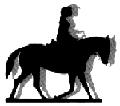 |
Training Mythunderstandings -
Choosing Bits.
Bits are one of the most MythUnderstood pieces of
horse equipment man has ever invented. The things that people think they're
supposed to do with a bit in a horse's mouth are unbelievable. |
All to often, the human take on the situation is
that a horse is a big animal, therefore the pressures needed to control it must
be big and strong. That's a myth. A rocket engine is controlled by tiny bits of
information being fed one at a time by a computer. Each of those bits is either
a "zero" or a "one". The bits flow in a pattern called a
program that the rocket understands. Same thing with a horse. All it needs are
tiny bits of information fed to it with the right timing to get with the
program.
There are very few surfaces where the bit can
apply pressure. So it takes some pretty complex applications of pressure to
those few points to create complex communication. The bit must be shaped in
such a way and fit properly within the mouth so horse is able to understand
what the communication is. Therefore a bit must be both directional and horse
logical. It must not cause any injury which will result in temporary numbness.
Please click here to
continue |
| 28th December
2000 |
The New, Faster Message Board.
The message board software has now been
upgraded to speed your browsing of the messages. The message board is located
at,
/archive/equiworld-net/chat5/ |
| 27th December
2000 |
The Andalusian
The Andalusian is one of the three foundation
breeds of modern horses, and eighty percent of all modern breeds trace at least
part of their breeding to the Andalusian. His influence is especially noted in
the Lipizzan, Friesian, Connemara, Cleveland Bay, Welsh Cob, and most American
breeds |
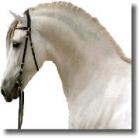 |
The Andalusian is perfectly suited for dressage
and "airs above the ground", war horse, bullfighter's horse or
western cattle horse. He is fiery and proud, but at the same time docile and
tractable. He is showy, elegant, strong and bold. His walk is showy, trot is
high-stepping and impulsive, and his canter is smooth and spectacular.
These are horses with easy response to command and
very sensitive mouths, resulting in a mount that is obedient and of
extraordinary comfort. They are temperate and hardy; noble and docile. They
learn rapidly and participate intimately with their riders.
Please click here to learn more |
| 26th December
2000 |
 |
Training Mythunderstandings -
Using Pressures To Shape The Horse.
Training horses involves using pressures to shape
a horse's behavior. But many people MythUnderstand how to use pressures
properly. |
Horses will learn when:
- they perceive you as a dominant best friend
within their herd,
- any pressure is not perceived as an
attack,
- any pressure is only one step away from
something the horse already understands, and
- if doing the correct thing relieves the pressure
which rewards the horse.
When all these things are in place, then the
pressure will be "horse logical." The horse will accept it calmly and
learn from it.
Many trainers attack horses. They think that if
the horse's activity level or excitement level increases, the horse is learning
more. That's one of the biggest MythUnderstandings there is in the training
world. In fact, the truth is just the opposite.
Please click here to continue |
| 25th December
2000 |
 |
What's In a
Meal?
the Equine Research Centre, Guelph,
Ontario
Goals
- Optimum health and performance
- Optimum nutrition
- Reasonable cost |
How to achieve the goals
1. Define your horse's current performance level ie. breeding, racing,
recreation etc. and body condition score.
(See ERC's Body condition scoring fact sheet -
click here)
2. Determine your horse's daily nutrient requirements based on the current
performance level and other factors such as environment (temperature, rain,
wind), age, breed. Use the National Research Council's Nutrient Requirements of
Horses,1989 or consult an equine nutritionist through your local feed dealer.
3. Determine feed composition by analysis. Knowing the protein, energy, fibre,
minerals etc. content of feeds is essential in order to feed for optimum health
and performance.
4. Balance the ration. Feed costs are a large expense; therefore, feed analysis
and ration balancing results in minimizing costs and maximizing the nutritive
value of your horse's diet.
Please click here to continue |
| 24th December
2000 |
The Click that Calms.
It was at Christmas time, several years ago, that
I began using the clicker to calm my horse, Dan. We'd had a heavy storm of
freezing rain that covered everything with a thick layer of solid ice for
nearly a week. Our little metal barn turned into an echo chamber as broken tree
branches came crashing down onto its roof. Every time he heard a noise, Dan
would jump and high tail it out of there. It didn't matter what or who was in
his way! It was every man (and horse) for himself!
The ice lay heavy on the trees and branches were
cracking like shot gun blasts. They weren't having a saturation effect on Dan
either, but rather his reactions were getting worse and worse. He was one upset
Curly horse! By the time he knocked me down on his charge through the doorway,
I decided that it was time for a change!
We started slowly inside the icy barn. I took a
metal rake and ever so lightly scratched the wall with it. Dan's head popped
up. His eyes got big and he ran out of the barn. He stopped a few feet outside
the doorway-I clicked! Dan's head swung around looking for the treat! The hook
was in! Now let the games begin!
Please click here to
continue |
| 23rd December
2000 |
WAP News Service.
For those with WAP enabled mobile
telephones you can now view the top 5 magazine news articles via your telephone.
Just add the following address to your telephones bookmarks.
/archive/equiworld-net/wapnews or
/archive/equiworld-net/wapnews
|
| 23rd December
2000 |
 |
Jeep Saddles Up for Different Kind of
Horse Power
Get ready to saddle up for the Jeep National
Riding Festival 2001!
The Festival, now in its fifth consecutive year, will be touring the UK once
again to give riding a substantial boost over the summer months - and there's
plenty in store for everyone! |
Supermodel Jodie Kidd got this year's festival
underway and it's gone from strength to strength, seeing riding schools across
the country getting involved and opening their doors to new recruits. Hundreds
of children have descended on riding centres nationwide to take up the reins
and have a go at riding thanks to the voucher system, offering discounted
lessons to encourage newcomers to the sport.
Please click here for further
details |
| 22nd December
2000 |
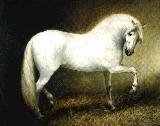 |
The Spanish Horse.
At first sight he takes your breath way with his
sculptural beauty, proud bearing, natural high action and docile loving
temperament. He is strongly built, yet extremely elegant with cat like agility
and whilst he presents a picture of splendid animation he is at all times
amenable to the person riding or handling him. . |
He is a horse of extreme character and his
eagerness to please in all he does makes him a truly magnificent mount or
driving horse. These magnificent Spanish horses are once again becoming very
sought after and are proving themselves in competition dressage, driving,
showjumping, demonstrating great versatility
Please click here to learn
more |
| 22nd December
2000 |
A Horse, of Course
with Don Blazer
You say you want a tough horse to do a
full day's work. But you don't want him to eat too much. And you don't want him
to go lame, but you do want him to live a long, long time.
How about a horse that thinks it's normal to work three or four days in a row
without stopping for rest or food?
Please click here to
read this article |
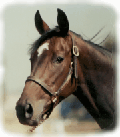 |
|
| 21st December
2000 |
 |
Safety Around
Horses
Equine Research Centre, Guelph, Ontario
A basic guide for beginning horse people.
Getting involved in horses is a wonderful and
rewarding way to learn new skills, develop a relationship with a fascinating
animal, and meet new friends in the process. |
Like many activities, however, equestrian sport
also involves some degree of risk. Horses are large, powerful animals, easily
capable of injuring a person. But, if you are well armed with a basic
understanding of horses, a few hard and fast rules, and your own good sense,
the risks are readily minimized.
Please click here to continue |
| 20th December
2000 |
 |
Training Mythunderstandings -
Self Control Precedes Horse Control
Merely causing a horse to do something does not
mean that you are in control of the horse. Think about the times you have seen
someone put a chain lead shank under a horse's chin or over its nose. They may
have been successful in leading that horse from Point A to Point B but the use
of that shank is a dead giveaway that they were not really in control. If they
were, coercive equipment would not be necessary. |
Trailer loading is another activity where you see
a lot of out of control horses. You may use a longe line or a buggy whip or
some form of bribery to get your horse into that trailer. Most horses
eventually give in to the pressure if you nag them long enough or coerce them
hard enough and they go on that trailer. But that is not training. Even though
you succeeded in causing the horse to do what you wanted him to do, you were
not really in control.
Please click here to
continue |
| 19th December
2000 |
 |
The Magic of India on
Horseback
Join A Ride into History with Inder Jit Singh and
John Crawford. |
It all began when the kilt wearing Scottish polo
player John Crawford made contact with Inder Jit Singh by e-mail. When Inder
Jit (aka IJ - a keen polo player) offered John the chance to escape Scotland's
winter weather and join him and group of riders in India the resounding reply
was "Yes! What a great way to start the New Year!".
If you are up for the holiday of a lifetime in
India this is the adventure for you.
You will be riding with John who has 35 years of
experience of training horses and riders. And I.J. who has a truly amazing
knowledge of the culture and regions of India. Set to be an informative,
testing, entertaining and a truly unique riding experience.
Adventure it most certainly will be, but with IJ
and John leading the rides, you will be in the hands of two very experienced,
good humoured horsemen and you will be riding some superbly behaved, beautiful
and finely schooled polo and riding ponies from the stables of no less than the
Maharaja of Udaipur. IJ and John are keen polo players so the first couple of
days may provide an opportunity to play or at least be introduced to "The
sport of Kings" in the very country where it originated. You may choose to
omit the polo sessions and use these days to acclimatise to your new
surroundings or take part in some intriguing trips and sight-seeing
expeditions.
Please click here to learn more |
| 19th December
2000 |
 |
Olympia International Show Jumping
Championships
Thursday 14th – Monday 18th December 2000
DESPITE THE RAIN OLYMPIA HAS ANOTHER
SUNSHINE YEAR |
As the curtains closed at one of the most popular
show jumping events in the world, the Olympia International Show Jumping
Championships (14th-18th December), organisers Clarion Events, announced that
it had been a near sell-out.
Whilst the rain and gales that hit the Channel at
the beginning of the week meant that the arrival of the international
competitors was delayed, they arrived just in the nick of time and the show,
once again, provided top class entertainment.
Please click here to learn
more |
| 18th December
2000 |
 |
The Bowmore Blair Castle International
Horse Trials Video
The Bowmore Blair Castle International Horse
Trials Television Programme is now online. It is available in the following
formats: Audio, 56k modem and ADSL. |
Hint, the ADSL versions provide the best quality,
if you can afford the time, download each section first to disk, then play,
(each ADSL section is approx. 20MB in size). They are well worth the wait!!!!
For the web page with links to the video,
/archive/equiworld-net/blair/
Or Higher Quality Files to download and save to
disk,
Part 1,
/archive/equiworld-net/video/2000-blair-p1-256k.rm
Part 2,
/archive/equiworld-net/video/2000-blair-p2-256k.rm
Part 3,
/archive/equiworld-net/video/2000-blair-p3-256k.rm
Part 4,
/archive/equiworld-net/video/2000-blair-p4-256k.rm
Note, you will need to have the RealMedia,
RealPlayer installed to play these files, you can get a free, basic version
from, http://www.real.com/
|
| 18th December
2000 |
 |
To Vaccinate or Not to
Vaccinate
the Equine Research Centre, Guelph,
Ontario
In most horse operations, vaccination forms an
integral part of the overall preventive health program for infectious
disease. |
To use or not to use a particular type of vaccine
in a certain situation is a question that is often asked of veterinarians. This
decision depends on the risk/benefit analysis of the particular disease in
question. Benefits of not acquiring a significant disease situation on farm are
rather obvious. In performance horses, the goal of the preventive health
program is to minimize or even eliminate the time spent out of training in
order to maximize earning potential. Risk of acquiring a disease depends on all
of the factors that contribute to the likelihood of a horse getting that
disease.
Please click here to learn more |
| 17th December
2000 |
Energy Needs Of Horses Vital In Feeding Management.
Eating well is not always eating safely; horse
managers who ignore that lesson when feeding their animals may be creating
digestive problems for their horses.
"Many feeding management recommendations for horses are related to
supplying energy safely," said Dave Freeman, Oklahoma State University
Cooperative Extension equine specialist.
One source of energy that horses rely on is fiber. Hays and pastures supply
energy in the form of fiber. Typically, horses should have access to pastures,
hays or coarsely processed forage at minimum levels of 0.75 percent of body
weight per day. "Long-stem forage has many advantages: intake is slower,
generally it can be fed free choice and it guards against feeding too much
carbohydrate energy because hays are low in starches and sugar," Freeman
said.
Please click here to coninue |
| 16th December
2000 |
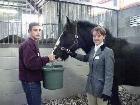 |
Urban Cowboys turn to Study
Thursday 14th December saw the official opening of
a unique humanitarian and equine welfare project in the heart of a large Dublin
housing estate. |
The Fettercairn Youth Horse Project in Tallaght
was conceived in 1995 by a group of adults and young people. The initial aims
were to help channel interest and respect for horses into a constructive
community activity that would provide local youths with opportunities to
develop personal, social and vocational skills. By September of that year the
group was catering for 40 young people between the ages of 10 and 25
years.
Please c;lick
here to learn more |
| 15th December
2000 |
The Orlov-Rostopchin.
Russian Riding horse Black of exotic beauty and
substance for dressage and pleasure. Now quite rare.
The Orlov-Rostopchin is an exotic horse.
Everything about it is unusual and romantic: its appearance, its origin, its
fate. To begin with, it is a product of an exciting competition and a
brainchild of two aristocratic breeding talents, Count Orlov and Count
Rostopchin.. |
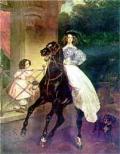 |
The two counts followed the same breeding
philosophies. And no wonder that when after their deaths their studs were
bought by the Crown, the Orlovs and Rostopchins were merged to give rise to
Orlov-Rostopchins
The Orlov-Rostopchin combines the size, type and
dressage abilities of the Orlovs and the speed of the Rostopchins. The
Orlov-Rostopchin is a versatile and willing worker. He has a quiet temperament
and is quite trainable. This all makes these horses good for dressage.
Please click here to learn more |
| 15th December
2000 |
Combat Cold Weather Nutritional Stress In Horses.
It's a lesson in thermodynamics: Humans combat
cold weather by putting on additional clothing; horses fight the elements by
using more energy to maintain body temperature. But while most people can
address their own needs, horses are dependent upon their owners to provide
proper nutrition and protection from the weather, said Dave Freeman, Oklahoma
State University Cooperative Extension equine specialist.
"The temperature below which a particular
horse starts to expend additional energy for maintaining body warmth (critical
temperature) will vary because of fat cover, hair thickness, acclimatization of
the horse to cold, hair-coat wetness and wind-chill," Freeman said.
Please click here to continue reading |
| 14th December
2000 |
 |
Olympia International Show Jumping
Championships
Thursday 14th – Monday 18th December 2000
FORCE 9 GALES DELAY INTERNATIONAL
ARRIVALS |
The freak weather conditions which have brought
flooding to much of the country are delaying the arrival of the 24 foreign
riders to the Olympia International Show Jumping Championships (14th-18th
December). Gordon Ashman of the show’s travel company, Shelley Ashman, has
reported that the horseboxes are still on the dockside at various European
ports waiting for the strong winds to abate.
Please click here to learn
more |
| 14th December
2000 |
Traxdata Interview
Traxdata Interview, owned by Mrs. Gail
McBride and ridden by Tim Stockdale, has died peacefully in his stable at the
age of 20. Punky, as he was known, was retired from competition at the Traxdata
Hickstead meeting earlier this year.
Please click here
for the full story |
| 14th December
2000 |
 |
Heat Dissipation and
Dehydration
By Dr. Kerry Ridgway, Equisport Enterprises,
CA, USA Excerpts from "On to Atlanta" published by the Equine
Research Centre, Guelph, Ontario |
The single most important means the horse has for
getting rid of the enormous heat load generated during exercise is evaporation,
accounting for about 65% of the heat dissipation. Sweat is evaporated off of
the skin surface and cools the horse. The lungs account for about another 25%.
This capacity of the respiratory tract in dissipating heat from the body
becomes very important under conditions of high humidity and high temperature
when evaporation conditions are not favourable.
Sweating can only occur at a significant level when the horse is not dehydrated
and has plenty of fluids in its body with which to produce sweat. When the
horse is dehydrated, the lungs play an even more important role. Even so, the
dehydrated horse is severely handicapped in ability to rid the body of any
excess heat.
Please click here to learn more |
| 14th December
2000 |
|
| 13th December
2000 |
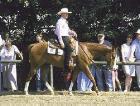 |
Training the Western Pleasure
Horse
by Hardy Oelke
In order to successfully train a western pleasure horse, you must first pick
the right kind of horse. Your training can improve any kind of horse, but to
end up with a competitive pleasure horse you need to start with the kind
"raw material". |
The most important requirement is that this horse
is a pretty mover. Pretty may be different things to different people, but in
western pleasure it means a horse that naturally moves in a more or less
collected way, with fluent, flat strides, its hind legs always well under him,
and with its neck and head carried level. The more strong-out horse can be
improved on, but will never become a tough pleasure horse. Our western pleasure
prospect should be a pretty horse of good size, preferably even a flashy one,
that moves gracefully - an eye catcher!
In your actual training, your goal is to teach
your horse so he never wants to go fast, waits for your cues without ever
getting in a hurry, but still stays collected. You want him to do all that on a
slack rein and while staying in the same "frame" all the time, no
matter what gait you are executing.
Please click here to learn more |
| 13th December
2000 |
The Horisen Centre Christmas Appeal
The Horisen Centre of Riding Therapy
operates programmes for children who have been abused or beaten, offering peace
for children in Ireland through inter-community education with horses. The
small ponies and small people programme is for terminally ill children Horisen
also offers equestrian education training for blind adults and children.
The Horisen Centre would love to hear from
anyone who is willing to help a child smile through support and financial
contributions.
Please click here to find out how you can
help
Horisen is a registered charity in Northern
Ireland, charity registration no. XR12583 |
| 12th December
2000 |
 |
Training Mythunderstandings -
Breaking Vs. Training.
Many people who are training horses will ask them
questions that the horse has no way of understanding or answering. Then they
will fight with the horse or hold him hostage until the horse either gives in
or gives up. The so-called trainer walks away feeling like he or she has won
the game because the horse finally did what they wanted him to do. But no
actual communication took place. What happened was "breaking" not
training. |
When you break a horse rather than train it, you
get a trained flea. What do I mean by that? Well, you start training fleas by
putting them in a jar. You know they are going to jump and if they do that,
they'll jump out of the jar. So you put a lid on the jar.
Now when the fleas jump, they hit their heads on
the lid. Being smart fleas, they learn not to jump so high. Now you can take
the lid off and they won't jump out. Voila! You have trained your fleas not to
jump so high. That is exactly what you do when you "break" a horse. A
lot of people train horses this way. They condition the horse to random tasks
one by one. They do not do it in a systematic way that is logical to the horse.
Please click here to continue reading |
| 12th December
2000 |
A Horse, of Course
with Don Blazer
I call 'em like I see 'em.
So, I say anyone supporting our present EIA (equine infectious anemia)
eradication program is lacking in normal intelligence or understanding, is
slow-witted or dull.
Please click here to
read this article |
 |
|
| 11th December
2000 |
Monday 11th December - Your Last Chance to Enter the
 |
Pet
& Garden Competition !
Enter this great free competition to win special
gifts for your favourite pet! |
 |
Each entrant will also receive a complimentary
discount voucher book for use when purchasing products from the Pet &
Garden or Hunter Horse Care ranges. Note: This competition is restricted to UK
residents and only one entry per household
Sorry, this competition is now
closed |
| 11th December
2000 |
The 7 Games and Clicker Training.
For centuries men and women have gotten together
to discuss ways to make things better for the horse. Through Natural
Horsemanship we are asking the horse to do a lot of un-natural things though.
Be around people. Be saddled, bridled and ridden. Natural, to me, means working
within a horses natural way of understanding (this is through feel) and within
his own boundaries. With all of the games I am looking towards building a
partnership. I'm thinking a lot about feel and developing that from the very
beginning.
The Seven Games are not about winning or losing. A
horse does not know about winning or losing, unless we teach it to them. I
prefer not to teach that. Instead I'll think about setting things up in a way
that my horse can best understand and then use the clicker to encourage
reinforce that understanding. The Seven Games are an excellent guide to teach
us about body position, observing your horse and improving rope handling
skills.
Please click here to learn
more |
| 11th December
2000 |
The equiworld.net video library.
On this page you can find links to
videos encoded by Equiworld.
Before you can view the files you will need to
have downloaded and installed the RealPlayer product. A number of versions are
available, including a free version. You should visit
www.real.com and follow the
links to the player version which best matches your system.
Please click here to view! |
| 10th December
2000 |
 |
Body Weight
Equine Research Centre, Guelph, Ontario
Body weight monitoring is important for feed
management, medication and animal health. Subtle changes may not be noted using
body condition scoring. A change in weight of 16-20 kg is necessary for the
body condition score to vary by 1 (eg. 4 to 5) Weight loss/gain may indicate a
health problem that requires veterinary assistance. |
The only accurate way to know your horse's weight
is by using a scale. This can be accomplished by purchasing a livestock unit or
by using a feed mill's weigh scale. Weights should be recorded in the health
record for future reference.
Please click here to learn
more |
| 10th December
2000 |
Horses Grazing Fescue Require Sound Management.
The ability to use tall fescue as pasture for
horses is a helpful aid to many owners' pocketbooks, though it is a practice
that takes sound management.
Much of Oklahoma's fescue is infected with an endophyte that can cause health
problems in horses. Unfortunately, ridding pastures of fescue is difficult,
time-consuming and expensive.
"Unless the fescue in your pasture has been planted with 'endophyte-free
seed' the past few years, and was entirely devoid of fescue before then, you
can count on the fescue to be endophyte infected," said Dave Freeman,
Oklahoma State University Cooperative Extension equine specialist.
Please click here to learn
more |
| 9th Decmber
2000 |
 |
International Horse Welfare Charity
Welcomes EC Report
A Review of the EC Directive on the Transportation
of Live Animals out today is welcomed by a UK equine welfare charity.
The International League for the Protection of
Horses (ILPH), a leading International horse welfare charity, welcomes the
recommendations made in the review, which covers transport for all live
animals, but particularly those specifically outlined for the transport of
equines.
Please click here for further
details |
|
| 9th December
2000 |
|
| 8th December
2000 |
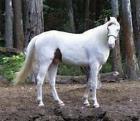 |
The Medicine Hat Horse
Medicine Hat is the name applied to horses
exhibiting a unique and rare pattern of color. Being mostly white in body,
Medicine Hats have color on their ears and top of the head, which resembles a
bonnet or hat. Color on the chest is termed a shield. Other areas of color
vary, but may show around one or both eyes and in the flanks. |
Often one or both eyes are partially or totally
blue, especially when the area around the eye is unpigmented. There are
exceptions, some have dark eyes surrounded by white skin. They may be of any
base color, often roaning of the base color is present as well. Medicine Hats
are described by their base color such as bay Medicine Hat, black roan Medicine
Hat, chestnut Medicine Hat etc.. War Bonnet is a name given to horses of a
similar pattern which exhibit less color, usually having just the Hat and very
little, if any, other colored areas.
Please click here to learn more |
| 8th December
2000 |
The Trillium Fellowship Award
In appreciation for the outstanding volunteer
service the farm has received over the years from so many, the Sampsons decided
to recognize these special individuals who have been generous in their support
of the farm, its activities and its horses. |
 |
Also presented at this event are "In
Appreciation" awards. These lovely etched glass medallions honor certain
people who have offered their assistance as well. It is the Sampson's way of
saying thank you.
Please click here to continue |
| 7th December
2000 |
 |
"Bedding in the horse stable...a
breath of fresh air".
Equine Research Centre, Guelph, Ontario
The health and well being of horses depends on healthy lungs. Poor air quality
can contribute to various respiratory disorders in horses and in the people who
care for them. |
Your choice of bedding will depend on a
combination of personal preference, cost effectiveness, local availability and
type of horse housed. Bedding should be dust and mould free, absorbent,
supportive and easy to use and dispose of. A barn with proper ventilation and
floors with good drainage are as important as your choice of bedding.
Please click here to learn more |
| 7th Deccember
2000 |
A Horse, of Course
with Don Blazer
A long stretch limo pulled up to the
ranch gate and a man dressed in black, wearing a chauffeur's cap stepped out
and asked, "Is there a Mr. Walter at this address?"
"There's a Walter," I replied. "But he's a horse, of course. Are
you sure it's a Walter you're looking for?"
Please click here to
read this article |
 |
|
| 7th December
2000 |
Seven Steps To Establishing A Behaviour
1. Train one element at a time.
2. Get a response, get it consistently, then
improve on it.
3. Raise your standards in small enough steps that
the animal continues to be successful and can be reinforced.
4. Once the behaviour is established, shift from a
fixed to a variable reinforcement schedule to improve response.
5. When adding a new criterion, temporarily relax
the standards of the old one.
6. If behaviour deteriorates, go back to a
previous step in the training process.
7. If one training procedure is not creating
progress, find another. There are many ways to build the steps to the desired
behaviour.
Please click here to visit the Clicker Training
section |
| 6th December
2000 |
 |
Horse Trials Video
Online
The entire Armathwaite Hall Horse Trials &
Country Fair 2000 video is now available online.
As broadcast on TV,it is available in formats,
Audio, 56k modem and ADSL.
Please click here for further
details |
|
| 6th December
2000 |
 |
Baileys Support British Sport Horse
Breeding
Baileys Horse Feeds are to support the British
Horse Database Leading Sire Rankings from 2001. |
Based on performance data supplied by British
Dressage, British Eventing and the British Show Jumping Association, the
Rankings have fast become the focus of sport horse breeders' attention on their
publication in Sport Horse Annual in January each year.
Please click here to learn more |
| 6th December
2000 |
Pedigree Horse Trials Sponsorship
Pedigree Masterfoods has decided, after sponsoring
Eventing since 1987 and the Burghley Pedigree Horse Trials since 1995, that
2001 will be the last year of their title sponsorship programme within the
sport.
The company will continue to remain involved in
Horse Trials from 2002 through its support of the Winergy Young Event Horse
competition, which incorporates 20 regional heats and a final at Burghley. It
also plans to maintain a presence at Burghley together with running the
ever-popular Pedigree Fun Agility competition, which has raised over
£40,000 for the Horse Trials Support Group.
Please click here for
further details |
| 5th December
2000 |
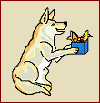 |
Equestrian Shopping
Online
Visit some of the best online equestrian
shops!
One of a kind Native American and Southwestern
silver jewelry, beadwork and crafts, from Coyotes Game.
Shop at home, yet choose from the largest
international collection of equestrian sport articles with Divoza!.
Gifthorse USA, Quality gifts to please every horse
lover,from watches and books, to toys, totes & bags
Buy or sell new horse tack, used horse tack,
saddles, bridles, bits, riding apparel, and more with Bits and Bridles
Please click here for
further information and links to a huge variety of online
retailers |
 |
|
| 5th December
2000 |
BHS Warns of Unscrupulous Dealers
The British Horse Society has issued a
warning to horse owners about the dangers of unscrupulous dealers. Reports have
been coming in that dealers are advertising in equestrian magazines for
'companion' horses. Owners are selling their horses to these people in good
faith, thinking that their much loved horse or pony will spend the rest of its
days being cared for in pleasant surroundings as a companion to another horse.
However, the BHS has received complaints that dealers posing as private owners
seeking a companion horse are in fact selling the horses on, either at sales or
to the meat market.
Please click here for
further details |
| 5th December
2000 |
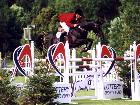 |
Vechta Awarded Gold Disc Performance
Status by BSJA
Since the recent announcement from the BSJA on the
stallions awarded Silver and Gold Disc Performance Status, Jackie Knightley of
the BSJA has confirmed to Caroline Thomas at New Priory Stud that VECHTA by
Voltaire has been |
awarded GOLD DISC performance status following his
Nations Cup performance in Rome. VECHTA is owned by Mr D Barnwell and William
Funnell who says......
Please click here to learn
more |
| 4th December
2000 |
The Lipizzaner
The Lipizzaner Horse's ancestors can be traced
back to 800AD. They were Berber horses brought to Spain by the Moors from North
Africa via Gibraltar. These Berber horses were then crossed with Karst horses
as used by the ancient Romans for chariot racing and other sports, as well as
being used as war horses in the Middle Ages. |
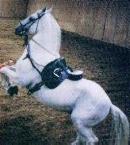 |
Although, historically, the Lipizzaner is a
carriage horse, and a dressage horse, especially famous for the 'Airs above the
Ground' as performed at the Spanish Riding School in Vienna - it is also used
in many countries for trial driving, endurance (long distance) riding,
showjumping and a few are in circuses.
Please click here to learn more |
| 4th December
2000 |
 |
Golden Moments
Look out for the new Baileys Golden
Chaff sacks. Produced to compliment their complete Range of Horse Feeds, Golden
Chaff has been reformulated and repackaged as part of Baileys ongoing policy to
review and improve products. . |
Golden Chaff is a lightly molassed oat straw chaff
which now contains a special blend of molasses to give a sugar content of
approximately 10%. This is lower compared to standard types of molassed chaff
and is suitable for most types of horses and ponies that have chaff included
into their feed. The new blend also ensures a more even coating making the
chaff easier to handle as well as being less sticky.
Please click here
for details |
| 4th December
2000 |
New Drug-Free Pain and Lameness Therapy for Horses
Announced
EquiMend, a new drug-free pain and lameness
treatment for horses, was introduced to the horse industry today, according to
Access Equine Inc., an equine marketing firm.
EquiMend is an innovative self-activating
invention that holds therapeutic micro-currents within its patented cloth
design and time-releases the treatment to the horse's injury over a 48-hour
period, without the use of electrical connections, batteries, drugs or
medications. The product's technology was awarded the prestigious gold medal
for best invention at the 35th annual World Trade Fair in Brussels.
Please click here to learn
more |
| 3rd December
2000 |
 |
When it is Time to Say Goodbye.
- a tribute to H-Loli and Serenity Intrigue -
|
On the early morning of November 23, 2000, with
temperatures plummeting to an unseasonably 10 degrees Celsius, I opened the
stable door, turned off the alarm and began the morning chores as I have done
with regularity every morning. It was the American Thanksgiving holiday and in
a way I too was giving thanks to these two American bred Morgans for the last
time. The routine was kept the same, but this was no ordinary day. It would be
the last morning that I would feed and water two old and dearly loved friends,
H-Loli and Serenity Intrigue.
Please
click here to continue reading |
| 3rd December
2000 |
 |
News from Grifone Club Milano
Results and much more about the
C.S.I.-C 1/3 Dec'00 in real time program Special Gift and Prizes prize money
risults the placing and nationalities of all competitors and their horses
obstacle-course of every cathegory in 2D and 3D kind of obstacle and ...
realtime video/audio
Please click here for
details |
|
| 2nd December
2000 |
 |
Training Mythunderstandings - Horse
Logic.
Good horse training is boring to watch. It looks
like nothing is happening. Many people are impressed by training methods that
are nothing more than a blatant series of attacks on the horse because they are
dramatic to watch. However, physically dominating a horse does not teach him
anything. To train a horse, you must use mental strength, not physical
strength. |
Training horses starts with understanding how
their minds work. You have to understand what is logical to the horse. The
horse's mind does not work the same way as yours. They do not associate events
or a sequence of actions in the same way we reason that things are related. To
train a horse, therefore, you have to understand how horse logic works and base
your training on that.
Please click here to continue reading |
| 2nd December
2000 |
Catch Traxdata on
Eurosport this Weekend!
Peter Charles in your front room Friday, Saturday
and Sunday night!
Traxdata Team's very own Peter Charles is competing at the Amsterdam CSI-W show
this weekend and coverage can be seen on Friday, Saturday and Sunday night.
Please click here for further details
|
 |
|
| 1st December
2000 |
|
| 1st December
2000 |
 |
Housing the
Horse
Equine Research Centre, Guelph, Ontario
The horse may spend approximately 22 hours per day
in its stable. Stable design and management can have direct effects on the
health of horses. Perhaps the most widely appreciated diseases in this context
are those affecting the horse's respiratory well-being. |
However, the horse is more than just a set of
lungs. The risks of other diseases and indeed direct physical trauma can be
increased by poorly designed stables. The incidence of many of the so-called
stable vices of horses can be increased by stable design. Stables themselves
aside, problems may also arise from the design and positioning of ancillary
buildings, such as feed- storage areas. Surfaces in stables, passageways and
walks around stables can also increase the risk of disease and injury.
The design, selection and positioning of new
stables or alterations to existing buildings, require careful planning to avoid
unnecessary problems. The money invested in these buildings is not always an
indication of their effectiveness in terms of housing the horse. The well being
of horses housed in the most carefully designed stables can be compromised by
the use of contaminated feeds and beddings or management practices such as deep
litter bedding.
Please click here to learn more |
| 1st December
2000 |
 |
Olympia International Show Jumping
Championships
Thursday 14th – Monday 18th December 2000
LUCY SPEED TO JUDGE FANCY DRESS AT OLYMPIA |
Lucy Speed who plays Natalie Evans in, the
BBC’s, Eastenders will be judging the Fancy Dress Pairs Relay during
the Sunday evening performance at the Olympia International Show Jumping
Championships (14th-18th December), in London. Lucy famous for her part as the
long-suffering wife of Barry in the hit soap will be judging each pair on their
humour value and their costumes.
Please click here for
details |
 |
|
|
|
Copyright 1994 to 2024 Equiworld at Hayfield, Aberdeen, Scotland - 30 years on the web. Archived Version.
|

